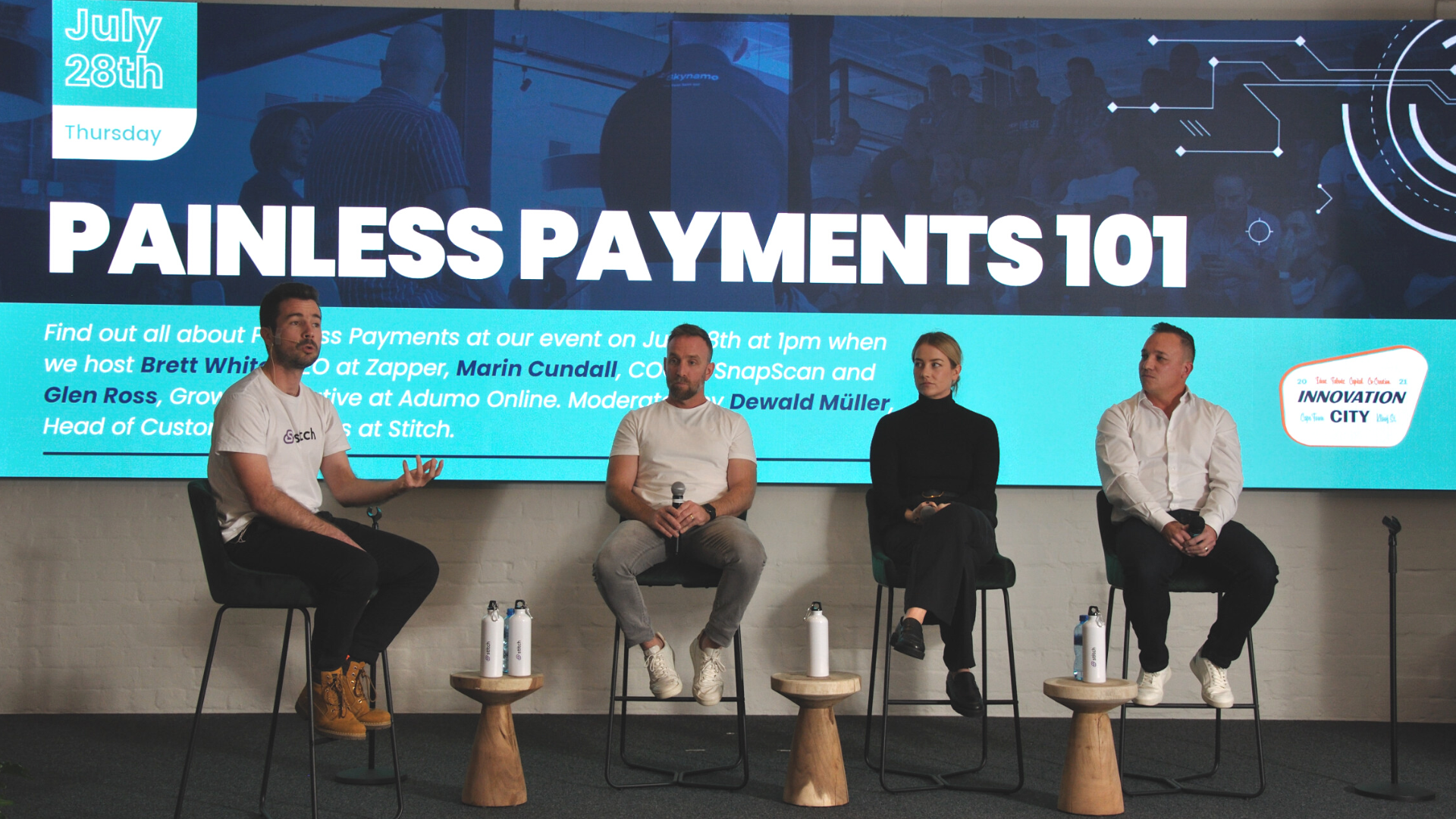
10 Aug Did you just say ‘ZapScan?!’ Why we all need seamless payment solutions…
“Do you use Snapper or ZapScan?” I’m told people often mix these up. Something that you can’t mix up though, is the very tangible success that scan-to-pay online payment apps like Zapper and SnapScan have had in South Africa.
Dewald Müller is Head of Customer Success at Stitch, an API infrastructure company used by many payment apps for its ability to verify identity, view transaction and balance data, enable instant, fraud-free bank payments and more. He graciously agreed to moderate an all-star panel consisting of Zapper CEO Brett White , Marin Cundall, COO of SnapScan and Glen Ross, Growth Executive at Adumo Online, at the Painless Payments 101 event at Innovation City.
‘Simple, painless and seamless’ are the apparent buzzwords when describing this kind of digital payment solution. As customers, at some point, we’ve all been in a situation where we couldn’t pay for something using our bank cards. This really sucks the first time it happens, because perhaps you’ve eyed a giant double chocolate chip fudge vegan walnut mocha matcha chai cookie, and it’s now all wrapped up and staring at you, and you can’t have it because they ‘don’t take card!’
If only weekend markets had wifi that allowed for the speedy download of a payment app, am I right, fellow Saffas?! You learn your lesson: The next time around you come fully prepared with a payment app downloaded, and that cookie is yours for the munching. These simple to use apps work by storing your credit and cheque card details through secure encryption on your mobile phone, and all you do is use your camera to read the merchant’s QR code which then prompts you to pay. Voila!
What does a good, seamless payment experience mean for the end user? According to Cundall, the general approach at SnapScan is to get out of the way: “Know your general customer segment. It’s all about managing the trade-off between providing every payment option, and how much time it takes for you to manage these,” she said.
Ross agrees: “Keeping it simple is key. Every step you introduce is another key step. There are different types of consumers out there and they will gravitate toward a payment method that is suitable to them,” he said.
But what about new business owners? What about the over-complicated cookie makers? What advice should they follow when looking for a payment option for their business?
Payment is undoubtedly an important component, says Zapper CEO Brett White. But take heed: “Merchants are consumers as well and have their own personal preferences. So there’s a bias. If they’re not a fan of new tech, they need to be educated about the opportunities. At the end of the day, merchants just want to get paid and be able to cash up at the end of the day. If you can make reconciling easy, you’re winning!” he said.
“Listen to your customers. You’ll find out pretty quickly how people want to pay when you start the business,” said Cundall.
Glen Ross, who has been in business development for almost two decades, spoke of a transition process when trying to figure out what payment methods fit your customer best: “You need to find out if there is an appetite for the tech option. The lady who makes lovely earrings will always sell to friends and family first. If your market is a trendier market, the interest to pay via apps will be there. If they’re older however, they will unfortunately have a resistance to the tech. One thing is certain, the bank card will always be a constant. There will be different solutions from different providers that will be helpful at different stages in your business journey,” he said.
Currently, there are a lot of online payment providers available in SA: Payfast, Ozow, Peach Payments, PayU, PayGate, Payflex, Yoco…the list goes on. Can there be too many payment options? “The options are driven by consumer demand. The more options the better,” thinks White.
With all these options, how do they compete? Zapper does this by offering in-app digital loyalty cards: “Loyalty is a big driver of behaviour in SA. There’s a big psychological component to it. Loyalty is a reward for merchants trying to gain customers and keep their attention,” White said.
There are however also some drawbacks to being an online payment company. In South Africa, a QR code transaction is still sadly and somewhat conspiratorially considered to be an e-commerce transaction, which is a percentage or two higher than when using a traditional bank machine. And then there’s this: According to a recent Stitch survey, 55% of people in South Africa still use cash as a payment method.
There are many reasons for that. South Africa’s great economic divide plays a large part, and smartphones and wifi are not in big supply in poorer areas and townships, as well as data being extremely expensive all around. But there’s also an issue of when the merchant gets money in pocket after transacting:
“The reality as a startup is that if you’re not transacting every day, you could wait a week to get your funds. As you move through the journey, you will need to have your money liquid. We at Adumo facilitate that so the time is shorter. Also, there’s a fear factor in townships of not being part of ‘the protection.’ Cash pays protection dues,” Ross said.
Ducking the taxman, illegal activities, illegal immigrants. There are clearly many reasons to use cash. But online payment companies are working on ways to change this: “We have a quick capital product for merchants. Zapper will qualify them for a loan if their transaction history is good, with lower premiums for more transactions. We saw a great increase in card transactions because people understood the benefit from these lower-to-no premiums,” said White.
And for those existing businesses that have been using the same payment method for years? Is change on the cards for them, too? Certainly, says Cundall:
“Speak to your customers, watch and identify their behaviour. If you have access to analytics, check the data. You will know when your customers are missing this piece of the buying process,” she said.
Who wouldn’t want to make life easier in every way possible?! With tech advancements focused on uplifting businesses in the informal economy, one day soon that cash user percentage will be far less. As Ross said: “If you’re not enforcing a change of behaviour, then the behaviour will never change.”



